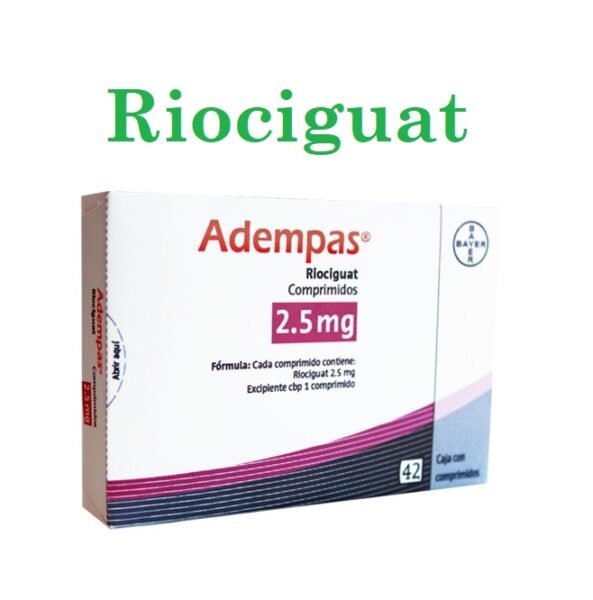Patients with pulmonary arterial hypertension and persistent thromboembolic pulmonary hypertension are treated with rociguat (Adempas). It results in pulmonary vascular dilatation and enhances the patient's capacity for exercise.
Riociguat Uses:
-
Chronic thromboembolic pulmonary hypertension:
- Used to improve exercise tolerance and WHO functional class in persons with persistent/recurrent chronic thromboembolic pulmonary hypertension (WHO Group 4) after surgical therapy or inoperable CTEPH.
-
Pulmonary arterial hypertension:
- Used to treat pulmonary arterial hypertension (PAH) in adults (WHO group 1) to increase exercise tolerance, raise WHO functional class, and prevent clinical deterioration.
Riociguat (Adempas) Dose in Adults
Riociguat (Adempas) Dose in the treatment of chronic thromboembolic pulmonary arterial hypertension and PAH:
- Oral: Starting dose is 1 mg TDS; those who might not tolerate the hypotensive effects may start with 0.5 mg 3 TDS. Systolic blood pressure should be increased by 0.5 mg TDS every two weeks until it reaches the greatest acceptable dosage if it stays above 95 mm Hg and the patient does not show any symptoms of hypotension. There is a 2.5 mg TDS maximum dosage.
-
Missed doses:
- If the therapy is stopped for more than three days, retitration is required.
-
Dosage modification for usage with potent multi-pathway CYP and P-gp/BCRP inhibitors concurrently (eg, azole antifungals or protease inhibitors):
- A starting dose of 0.5 mg TDS should be considered.
-
Dosage adjustment for smokers:
- If the patient tolerates, may titrate dose to more than 2.5 mg TDS. If the patient quits smoking during therapy, a decreased dose may be required.
-
Switching from a PDE-5 inhibitor to riociguat in patients:
- At least 24 hours should pass between taking sildenafil and taking riociguat.
- Riociguat should not be used for at least 48 hours before Tadalafil is administered.
- In patients susceptible to hypotension, begin riociguat at 0.5 mg three times per day.
-
Switching to a PDE-5 inhibitor from riociguat:
- Riociguat must to be stopped at least 24 hours before using a PDE5 inhibitor.
Use in Children:
Not indicated.
Pregnancy Risk Category: X
- Contraindicated in pregnancy.
- Due to the potential for fetal harm, it should not be given to pregnant patients.
- Encourage women suffering from pulmonary arterial hypertension to abstain from pregnancy.
- Female patients who are or may become pregnant should exercise caution. Pregnancy should be avoided before to starting treatment, throughout treatment, and for one month after treatment is finished.
- Effective contraception must be taken both throughout therapy and for one month after it is finished in order to avoid pregnancy in women with reproductive potential.
- No matter their level of reproductive potential, all females must sign up for the REMS programme.
- Females with reproductive potential should fulfill the requirements for contraception and pregnancy testing.
- It is advised that people pick just one method of birth control, whether it be tubal ligation, an intrauterine device, or contraceptive implants.
- In the event that a patient chooses to have a vasectomy with a partner, a hormonal barrier or contraceptive must also be administered.
- Women should be advised to prepare ahead for pregnancy and to notify their prescriber right once if they become pregnant.
Dose in Kidney Disease:
- CrCl 15 or less mL/min: The manufacturer's labelling makes no mention of changing the dosage.
- CrCl <15 mL/minute: Not recommended for use(has not been studied)
- Dialysis: Not recommended for use(has not been studied)
Dose in Liver disease:
- Mild to moderate hepatic impairment:
- The manufacturer's labelling makes no mention of changing the dosage.
- Severe hepatic impairment (Child-Pugh class C):
- Not recommended for use(has not been studied).
Side effects of Riociguat (Adempas):
-
Cardiovascular:
- Hypotension
- Palpitations
- Peripheral Edema
-
Central Nervous System:
- Headache
- Dizziness
-
Gastrointestinal:
- Dyspepsia
- Nausea
- Diarrhea
- Vomiting
- Gastritis
- Constipation
- Gastroesophageal Reflux Disease
- Abdominal Distention
- Dysphagia
-
Hematologic & Oncologic:
- Anemia
- Major Hemorrhage
-
Respiratory:
- Hemoptysis
- Epistaxis
- Nasal Congestion
Contraindications to Riociguat (Adempas):
- Pregnancy
- delivery of nitrates and nitric oxide donors simultaneously in any form, such as amyl nitrite
- simultaneous treatment of PDE-5 and other phosphodiesterase inhibitors (eg sildenafil or tadalafil)
- Use sildenafil within 24 hours, 24 hours before, or 48 hours after taking tadalafil (or non-specific PDE inhibitors like dipyridamole or theophylline).
- Idiopathic interstitial pneumonia (PHIIP) and pulmonary hypertension are two potential causes.
Canadian labeling: Additional contraindications not in the US labeling
- Hypersensitivity (to riociguat, or any other component of the formulation) (to riociguat, or any other component of the formulation).
- Breastfeeding
Warnings/Precautions
-
Bleeding
- Be aware of bleeding as it can cause severe bleeding.
-
CNS effects
- When engaging in activities that call on mental clarity, such as operating machinery or operating a vehicle, patients should proceed with caution. brings down blood pressure
-
Hypotension
- If you experience symptoms of hypotension (such as hypovolemia, severe left ventricular blockage, resting hypotension, or autonomic dysfunction in patients), or if you are taking antihypertensives, potent CYP inhibitors, and/or P-gp/BCRP inhibitors simultaneously, you should exercise caution.
- For people who are at a greater risk of hypotension, start with a lesser dose. Reduce the dosage if hypotension develops.
-
Hepatic impairment
- Be careful. Use caution in severe liver dysfunction (Child-Pugh Class C).
-
Pulmonary venoocclusive disease
- It is not recommended to be used in patients suffering from pulmonary venoocclusive disease (PVOD). Patients with pulmonary edema that suggests PVOD should stop using it.
-
Renal impairment
- Be cautious. If your creatinine clearance is less than 15 mL/minute or if you are receiving dialysis, you should avoid using it.
Riociguat: Drug Interaction
Note: Drug Interaction Categories:
- Risk Factor C: Monitor When Using Combination
- Risk Factor D: Consider Treatment Modification
- Risk Factor X: Avoid Concomitant Use
Risk Factor C (Monitor therapy) |
|
| Alfuzosin | The hypotensive effects of blood pressure-lowering medications may be strengthened. |
| Anagrelide | May strengthen Riociguat's hypotensive effects. Treatment: Riociguat should not be used in combination with PDE type 5 inhibitors or nonselective PDE inhibitors. Other PDE inhibitors are not prohibited, but patients should exercise caution and have their blood pressure checked frequently. |
| Antipsychotic Agents (Second Generation [Atypical]) | Antipsychotic drugs' hypotensive effects may be enhanced by blood pressure-lowering medications (Second Generation [Atypical]). |
| Apremilast | May strengthen Riociguat's hypotensive effects. Treatment: Riociguat should not be used in combination with PDE type 5 inhibitors or nonselective PDE inhibitors. Other PDE inhibitors are not prohibited, but patients should exercise caution and have their blood pressure checked frequently. |
| Barbiturates | The hypotensive effects of blood pressure-lowering medications may be strengthened. |
| Benperidol | The hypotensive effects of blood pressure-lowering medications may be strengthened. |
| Blood Pressure Lowering Agents | May increase the hypotensive effects of agents associated with hypotension. |
| Bosentan | May lower the serum level of CYP3A4 substrates (High risk with Inducers). |
| Brimonidine (Topical) | The hypotensive effects of blood pressure-lowering medications may be strengthened. |
| Cilostazol | May strengthen Riociguat's hypotensive effects. Treatment: Riociguat should not be used in combination with PDE type 5 inhibitors or nonselective PDE inhibitors. Other PDE inhibitors are not prohibited, but patients should exercise caution and have their blood pressure checked frequently. |
| Crisaborole | May strengthen Riociguat's hypotensive effects. Treatment: Riociguat should not be used in combination with PDE type 5 inhibitors or nonselective PDE inhibitors. Other PDE inhibitors are not prohibited, but patients should exercise caution and have their blood pressure checked frequently. |
| CYP3A4 Inducers (Moderate) | May lower the serum level of CYP3A4 substrates (High risk with Inducers). |
| Deferasirox | May lower the serum level of CYP3A4 substrates (High risk with Inducers). |
| Diazoxide | The hypotensive effects of blood pressure-lowering medications may be strengthened. |
| DULoxetine | The hypotensive impact of DULoxetine may be enhanced by blood pressure lowering medications. |
| Enoximone | May strengthen Riociguat's hypotensive effects. Treatment: Riociguat should not be used in combination with PDE type 5 inhibitors or nonselective PDE inhibitors. Other PDE inhibitors are not prohibited, but patients should exercise caution and have their blood pressure checked frequently. |
| Erdafitinib | May lower the serum level of CYP3A4 substrates (High risk with Inducers). |
| Erdafitinib | P-glycoprotein/ABCB1 Substrates serum concentration might rise. |
| Herbs (Hypotensive Properties) | The hypotensive effects of blood pressure-lowering medications may be strengthened. |
| Hypotension-Associated Agents | The hypotensive action of hypotension-associated agents may be strengthened by blood pressure lowering medications. |
| Ivosidenib | May decrease the serum concentration of CYP3A4 Substrates (High risk with Inducers). |
| Levodopa-Containing Products | Levodopa-Containing Products' hypotensive effects may be strengthened by blood pressure-lowering medications. |
| Lormetazepam | May enhance the hypotensive effect of Blood Pressure Lowering Agents. |
| Milrinone | May strengthen Riociguat's hypotensive effects. Treatment: Riociguat should not be used in combination with PDE type 5 inhibitors or nonselective PDE inhibitors. Other PDE inhibitors are not prohibited, but patients should exercise caution and have their blood pressure checked frequently. |
| Naftopidil | The hypotensive effects of blood pressure-lowering medications may be strengthened. |
| Nicergoline | The hypotensive effects of blood pressure-lowering medications may be strengthened. |
| Pentoxifylline | The hypotensive effects of blood pressure-lowering medications may be strengthened. |
| P-glycoprotein/ABCB1 Inhibitors | Pglycoprotein/ABCB1 Substrates serum levels can rise. Additionally, p-glycoprotein inhibitors may improve the distribution of pglycoprotein substrates to particular cells, tissues, and organs where high levels of p-glycoprotein are present (e.g., brain, T-lymphocytes, testes, etc.). |
| Pholcodine | Pholcodine's hypotensive impact may be strengthened by blood pressure lowering medications. |
| Prostacyclin Analogues | The hypotensive effects of blood pressure-lowering medications may be strengthened. |
| Proton Pump Inhibitors | May lower the level of Riociguat in the serum. |
| Quinagolide | The hypotensive effects of blood pressure-lowering medications may be strengthened. |
| Ranolazine | P-glycoprotein/ABCB1 Substrates serum levels can rise. |
| Roflumilast | May strengthen Riociguat's hypotensive effects. Treatment: Riociguat should not be used in combination with PDE type 5 inhibitors or nonselective PDE inhibitors. Other PDE inhibitors are not prohibited, but patients should exercise caution and have their blood pressure checked frequently. |
| Sarilumab | May lower the serum level of CYP3A4 substrates (High risk with Inducers). |
| Siltuximab | May lower the serum level of CYP3A4 substrates (High risk with Inducers). |
| Tocilizumab | May decrease the serum concentration of CYP3A4 Substrates (High risk with Inducers). |
Risk Factor D (Consider therapy modification) |
|
| Amifostine | Amifostine's hypotensive impact may be strengthened by blood pressure lowering medications. Treatment: Blood pressure-lowering drugs need to be avoided for 24 hours before amifostine is administered when used at chemotherapeutic doses. Amifostine should not be given if blood pressure lowering treatment cannot be stopped. |
| Antacids | May lower the level of Riociguat in the serum. Management: To reduce the possibility of an interaction, provide antacids and riociguat at least an hour apart. |
| Antihepaciviral Combination Products | Riociguat serum levels can rise. Management: Take into account beginning with a riociguat dose reduction of 0.5 mg three times per day. Patients taking such a combination should also be thoroughly watched for any hypotension-related signs or symptoms. |
| Cobicistat | Riociguat serum concentration might rise. Treatment: Take into account beginning with 0.5 mg of riociguat three times per day. Additionally, patients receiving this combination should be closely watched for any signs or symptoms of hypotension. |
| CYP3A4 Inducers (Strong) | May speed up CYP3A4 substrate metabolism (High risk with Inducers). Management: Take into account a substitute for one of the interfering medications. Specific contraindications may apply to some combinations. the relevant manufacturer's label. |
| Dabrafenib | May lower the serum level of CYP3A4 substrates (High risk with Inducers). Management: When possible, look for substitutes for the CYP3A4 substrate. If concurrent therapy cannot be avoided, pay special attention to the substrate's clinical consequences (particularly therapeutic effects). |
| Enzalutamide | May lower the serum level of CYP3A4 substrates (High risk with Inducers). Management: When possible, look for substitutes for the CYP3A4 substrate. If concurrent therapy cannot be avoided, pay special attention to the substrate's clinical consequences (particularly therapeutic effects). |
| Itraconazole | May increase the serum concentration of Riociguat. Management: Consider starting with a reduced riociguat dose of 0.5 mg three times a day. Patients receiving such a combination should also be monitored extra closely for signs or symptoms of hypotension. |
| Ketoconazole (Systemic) | Riociguat serum levels can rise. Treatment: Take into account beginning with 0.5 mg of riociguat three times per day. Additionally, patients receiving this combination should be closely watched for any signs or symptoms of hypotension. |
| Lorlatinib | May lower the serum level of CYP3A4 substrates (High risk with Inducers). Management: When possible, look for substitutes for the CYP3A4 substrate. If concurrent therapy cannot be avoided, pay special attention to the substrate's clinical consequences (particularly therapeutic effects). |
| Mitotane | May lower the serum level of CYP3A4 substrates (High risk with Inducers). Treatment: When administered in individuals receiving mitotane, doses of CYP3A4 substrates may need to be significantly modified. |
| Obinutuzumab | The hypotensive effects of blood pressure-lowering medications may be strengthened. Management: Take into account temporarily stopping blood pressure-lowering drugs 12 hours before the start of the obinutuzumab infusion and keeping them off until 1 hour after the infusion is finished. |
| Protease Inhibitors | Riociguat serum levels can rise. Treatment: Take into account beginning with 0.5 mg of riociguat three times per day (for adults). Additionally, patients receiving this combination should be thoroughly watched for any indications or symptoms of hypotension. |
| St John's Wort | May lower the serum level of CYP3A4 substrates (High risk with Inducers). Management: Take into account a substitute for one of the interfering medications. Specific contraindications may apply to some combinations. the relevant manufacturer's label. |
| Tobacco (Smoked) | May lower the level of Riociguat in the serum. Treatment: If tolerated, increase the dose of riociguat in patients who smoke to 2.5 mg three times per day. Patients who give up smoking should take into account lowering their riociguat dosage. |
Risk Factor X (Avoid combination) |
|
| Amyl Nitrite | May enhance the hypotensive effect of Riociguat. |
| Bromperidol | The hypotensive impact of bromperidol may be enhanced by blood pressure lowering medications. Blood Pressure Lowering Agents' hypotensive effects may be lessened by bromperidol. |
| Dipyridamole | May strengthen Riociguat's hypotensive effects. |
| Doxofylline | May enhance the hypotensive effect of Riociguat. |
| Ibudilast | May enhance the hypotensive effect of Riociguat. |
| Molsidomine | Riociguat may enhance the hypotensive effect of Molsidomine. |
| Nitroprusside | Riociguat may enhance the hypotensive effect of Nitroprusside. |
| Phosphodiesterase 5 Inhibitors | May strengthen Riociguat's hypotensive effects. |
| Theophylline Derivatives | May strengthen Riociguat's hypotensive effects. |
| Vasodilators (Organic Nitrates) | May strengthen Riociguat's hypotensive effects. |
Monitoring parameters:
- Blood pressure
- Significant peripheral edema
- Improvements in pulmonary function
- exercise tolerance
- Monitor for pregnancy
How to administer Riociguat (Adempas)?
Oral:
- Can be administered with or without a meal.
- The pills can be crushed and combined with water or soft foods (such as applesauce) right before administration if a patient is unable to swallow full tablets. It acts in two different ways.
Mechanism of action of Riociguat (Adempas):
- By stabilising the NO-sGC interaction, it can make the soluble guanylate cycle (sGC) more sensitive to endogenous nitric oxide (NO).
- Without NO, roicoguat can also directly stimulate sGC.
- Riociguat activates the NO-sGC/cGMP pathway, which boosts the production of cGMP and causes vasodilation as a result.
Distribution:
- 30 L
Protein binding:
- Plasma: Highly protein-bound, i.e. 95%
Metabolism:
- CYP1A1, CYP3A, and CYP2C8 are the main players in metabolism.
- CYP1A1 is responsible for the major active metabolite, M1.
- Polycyclic aromatic hydrocarbons, such as those in cigarette smoke, can also cause it.
- M1's potency ranges from 1/3 to 10% that of its parent substance.
- The inactive N-glucuronide is produced as a result of further metabolism.
- Patients with pulmonary arterial hypertension have plasma levels of M1 that are approximately half the level for riociguat.
Bioavailability:
- ~94%
Half-life elimination:
- In patients, it's 12 hours while in healthy subjects it's 7 hours.
Time to peak, plasma:
- Almost 1.5 hours
Excretion:
- ~53% in feces
- ~40% in urine
International Brand Names of Riociguat:
- Adempas
Riociguat Brand Names in Pakistan:
No Brands Available in Pakistan.




 Injection.webp)